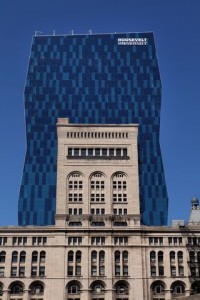The new 32-story Wabash Building has gotten a lot of buzz within the Chicago architecture scene the last few months as its official ribbon-cutting on May 5th approaches. Today’s lengthy review in the Chicago Tribune by the Pulitzer Prize-winning architectural critic Blair Kamin, though, is a watershed moment in the building’s emergence onto the Chicago skyline — as well as the region’s educational landscape. As Kamin writes,
[T]here is reason to think that Roosevelt University’s striking new $123 million tower in downtown Chicago (left) will amount to something more than an eye-grabbing envelope.
The 32-story tower, which flaunts a zig-zagging silhouette and an equally arresting skin of blue and green glass, represents Chicago’s latest innovation in skyscraper design. It is a vertical campus, stacking everything from a student union to lecture halls to dorm suites within a single, all-encompassing structure.
Located at 425 S. Wabash Ave. and known simply as the Wabash Building, the tower is the nation’s second tallest academic building after the University of Pittsburgh’s Cathedral of Learning. More important, it marks the first time that the dramatic expansion of colleges and universities in Chicago’s Loop has made a major mark on the city’s vaunted skyline. Happily, that impact is worth celebrating.
The tower’s powerfully sculpted exterior soars memorably above the mighty wall of historic buildings along Michigan Avenue (left), including Louis Sullivan and Dankmar Adler’s adjoining Auditorium Building, which has served as Roosevelt’s home since 1947. It achieves a genuine, artful dialogue between past and present.
As noted elsewhere in Kamin’s review, as well as in Laura Janota’s “Growing A Green Campus” essay in the Fall 2010 Roosevelt Review alumni magazine, the Wabash vertical campus is a LEED-Silver building that incorporates a host of sustainable features — from recycling facilities to energy- and water-efficient fixtures to sustainable building materials. As such, it is an integral part of RU’s continuing efforts to green its physical campus, from its buildings to its exterior landscapes (in the case of the 22-acre Schaumburg Campus).